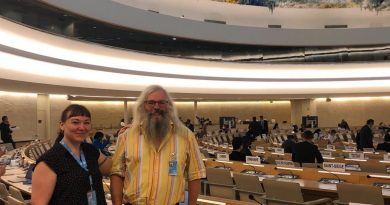Understanding the threats of Qur’an Burning, by Chaiwat Satha-Anand
Bangkok Post, September 12, 2010.
In the corner of a Sunday comic strip titled “Pastor Jones goes to New York”, there is a small character saying “ Your fifteen minutes are up reverend.” That may be true about Terry Jones’ personal fame since a month ago no one this side of the globe has heard about him or his tiny Protestant church in Gainesville, Florida, nor his 2010 book: Islam is of the Devil.
But when he announced the “International Burn a Koran Day” from 6 p.m. to 9 p.m. to be held on September 11, world attention descended upon him. Outcry against his proposed act from religious leaders around the world notwithstanding, world leaders from President Obama, to UN Secretary General Ban Ki Moon to David Howell Petraeus, a former professor of international relations, he received his Ph.D. from Princeton, and now the commander of US Force Afghanistan, all are in unison in appealing to the pastor to call this act off, fearing that it will provide some Muslims with justifications of holy anger that could further violence around the world, and American lives, among others, could be endangered. After the intervention of Imam Muhammad Musri, arranging a meeting with another New York Imam concerning the construction of an Islamic center and a mosque near the site of the 9/11 atrocity, Pastor Jones told the press that his Qur’an burning act would be put on hold for the time being.
If one agrees with Dominique Moisi in his recent book The Geopolitics of Emotion (2010) that one cannot fully understand the world today without trying to construe the ways in which emotions such as fear, humiliation and hope shape world politics, and that a clash of emotions between fear in “the West” and humiliation in the Muslim world is going on, then I would argue that what Pastor Jones has done was to show us how vulnerable to global violence the world is. More importantly, to live with such vulnerability, a genuine appreciation of such danger is to understand both the meanings of Qur’an in the lives of Muslims and the dangerous implications of books burning, sacred and otherwise, for freedom and violence.
The Qur’an and the Muslim Mind
I just read a Thai short novel about a Buddhist teacher who fell in love with the daughter of an Imam in a southern province. The man was first captured by the beauty of her voice reciting the sacred Qur’an. It is believed that the sound of the holy book could soften the human heart. I myself try to read the Qur’an everyday and felt that in the silence of the night, I could feel its power consoling my sometimes restless soul. To be a Muslim, there are 6 articles of faith one has to believe: in God, in His angels, in His books – and Qur’an is not the only one, in his prophets, in the end of days, and that all goods and ills come from God.
The Qur’an is a book arranged into 114 chapters with more than 6,000 verses. The Book has many names. Apart from being called “al-huda” or guidance post, it is called “Kalam-ul-lah” or “Words of God”. As a revealed religion, similar to Christianity and Judaism and different from Buddhism as an enlightened religion, Muslims believe that the Prophet Muhammad, who was illiterate, received God’s first revelation in a cave in the Mountain of Light in 610 CE. And the first time it came to him, it came in 5 verses:
“Recite in the name of your Lord who created,
Created man from blood coagulated!
Recite for your Lord is Most Generous,
Who taught by the pen,
Taught what they did not know unto men!”
(Chapter 96: verse 1-5)
A Muslim cannot touch the Qur’an, literally means to read or to recite, when s/he is unclean. Only after making ablution can s/he touch the book. Even when the books are worn out, they must be treated with respect. A Durban magazine, al-Ummah (2008) reports the case of Baker Wahid, a South African farmer who tried to collect worn-out copies of Qur’an and respectfully buried them in his own farmland. In the town of Quetta, West Pakistan next to Afghanistan border, in 1992 Haji Allan Noor Daavi began digging a cave in his friend quarry to create a depot for old worn-out copies of Qur’an and packed them in linen sacks. Presently, his endeavor has become a foundation called Jabal –e Noor al –Qur’an (Qur’an Mountain of Light) that continue to collect old and damaged copies of Qur’an to be either restored or buried.
Such reverence to Qur’an in the minds of Muslims need to be understood. So when Pastor Jones, in one of his interviews, pointed out that he would burn the Qur’an and though he said he might not like it, the Muslims could do the same to the Bible, he misunderstands two important points. First, as earlier indicated, the Muslims have to believe in God’s other holy books which include the Bible and the Torah as well, and therefore to even think about such possibility should be abominable to the Muslim minds in general. Second, the Muslims believe that words in the Qur’an are “Words of God” written right into the pure heart of an illiterate man untouched by other books. In this sense, from a comparative theological perspective, the Qur’an as the Words cannot be compared to the Bible, but to Jesus as Logos and for Christians in general- as the Son.
The proposal, now or in the future, to burn the Qur’an will therefore be a dangerously easy way to ride the escalation of existing conflicts involving Muslims anywhere in the world into the sphere of deadly violence when the sacred text is violated, and Muslims’ humiliation resulted from global politics becomes highly charged with collective anger.
The danger of book burning
From a secular perspective, the threat to burn Qur’an is another episode in the last 45 centuries of book burning. From 259 to 210 B.C. the Chinese Emperor Shih Huang Ti burned so many books and at least 460 Confucian scholars with them. In 640, Caliph Omar burned all the volumes in the library of Alexandria. The Mongols under Hulagu sacked Baghdad in 1258 and devastated its centuries-old libraries. The Christian missionaries who accompanied the conquistadors made bonfires of the Aztec and Mayan codices. In 1650, a religious pamphlet by William Pynchon was confiscated by Puritan authorities in Massachusetts, condemned by the General Court and burned by the public executioner in the Boston marketplace-perhaps the first incident of book-burning in America.
Closer to our time, on May 10, 1933, in most university towns, German university students burned more than 25,000 “un-German” books in ceremonies completed with band-playing and “fire oaths”. Among the books burned include those by Bertolt Brecht, Karl Marx, Ernest Hemingway, Thomas Mann, and the book – All Quiet on the Western Front by Erich Maria Remarque. In 1992, a Serbian commander spent three days destroying the National Library of Bosnia-Herzegovina in Sarajevo. What is it about books that they get burned and destroyed and desecrated throughout history?
Baez in A Universal History of the Destruction of Books (2010) raised a question why the destruction of books provokes a distinct sense of horror among us? People would rather give away a book rather than destroy it. Books, unlike any other inanimate objects, are extensions of human memory and imagination. They are burned precisely because of this connection to personal or communal identity. Books are made of words, and if it is through words that define who we are, burning them turn parts of our identity into fire, and then ashes.
Perhaps it is also important at this time to be reminded of the wise words of the beloved nineteenth-century German Jewish poet Heinrich Heine, whose books were also burned by the Nazi. Heine wrote in his 1820-1821 play Almansor the famous admonition: “Where they burn books, they will also ultimately burn people.”
Chaiwat Satha-Anand is part of CGNK’s Leadership Team.




